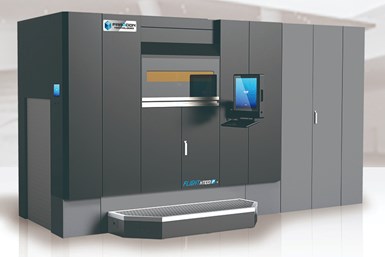Farsoon’s Quad-Laser Flight Technology Maximizes Production Yields
Farsoon’s Quad-laser Flight technology on the HT1001P large-format platform offers an enhanced manufacturing speed to maximize production yield and lower manufacturing cost per part.
The HT1001P large-format platform also features an expanded build volume of 1000 × 500 × 450 mm. Photo Credit: Farsoon
Farsoon’s Quad-laser Flight technology on the HT1001P large-format Platform is targeted for next-level, industrial-scale, high-quality plastic laser powderbed fusion (LPBF) production. Designed using the continuous additive manufacturing solution (CAMS) concept, the company says the Flight Technology HT1001P Platform is capable of continuous production capability.
Combined with an expanded build volume of 1000 × 500 × 450 mm, the system is said to offer enhanced manufacturing speed and ultimate yield. The Flight HT1001P Quad-Laser system is currently undergoing intensive beta testing at the Farsoon R&D facility in Changsha, China.
Following the introduction of its high-speed Flight technology (Flight short for “Fiber Light”) application on its 403P Series and high-temperature 252P Series, Farsoon has focused the on development of multilaser Flight technology on large-format platforms, which are said to maximize production yield and lower manufacturing cost per part.
The Flight HT1001P-2 Dual-laser system offers continuous production capability and improved levels of operational automation. Featuring a large build cartridge measuring 1000 × 500 × 450 mm and powerful dual or future quad 300-W fiber lasers, the Flight HT1001P platform offers rapid scanning speeds of up to 20 m/sec. (66 ft./sec.) for each laser.
The quad-laser development of Flight Technology on the HT1001P platform is said to offer a higher (up to 275%) production volume rate compared to a single-laser configuration of the Flight 403P Platform. The company says it also offer an increased production yield of 5.6 times compared to a single CO2 laser machine. Due to an exchangeable build cartridge and integrated conveyor system, the application of Quad-laser Flight Technology on the HT1001P system can boost machine uptime with an improved level of automation capable of achieving two full 225-L builds in a single day.
In addition, the Flight HT1001P platform is capable of achieving chamber temperatures up to 220℃ to process high-temperature materials such as PA6 for end-use parts. With a patented multizone heater and intelligent temperature control system, the Flight HT1001P platform can achieve uniform thermal distribution throughout the platform to ensure consistent mechanical properties and surface quality.
The system also features an open platform that enables users to have full access to a wide range of key parameters. These open systems enable fine-tuning process parameters with a large variety of third-party materials that best suit the needs of specific application and end-use part properties.
- Read about how Farsoon assisted commercial rocket launch company Deep Blue Aerospace in using industrial metal 3D printing for creation of a large combustion chamber.
- Learn how Farsoon’s LPBF systems for large-scale metal additive manufacturing are said to offer huge potential in aerospace applications by lowering operational cost and enabling true industrial-scale series manufacturing.
Related Content
-
Video: 5" Diameter Navy Artillery Rounds Made Through Robot Directed Energy Deposition (DED) Instead of Forging
Big Metal Additive conceives additive manufacturing production factory making hundreds of Navy projectile housings per day.
-
Additive Manufacturing Is Subtractive, Too: How CNC Machining Integrates With AM (Includes Video)
For Keselowski Advanced Manufacturing, succeeding with laser powder bed fusion as a production process means developing a machine shop that is responsive to, and moves at the pacing of, metal 3D printing.
-
With Electrochemical Additive Manufacturing (ECAM), Cooling Technology Is Advancing by Degrees
San Diego-based Fabric8Labs is applying electroplating chemistries and DLP-style machines to 3D print cold plates for the semiconductor industry in pure copper. These complex geometries combined with the rise of liquid cooling systems promise significant improvements for thermal management.















